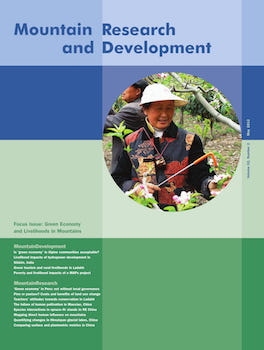The Third Dimension: A Comparative History of Mountains in the Modern Era by Jon Mathieu. Cambridge, United Kingdom: White Horse Press, 2011. x + 194 pp. £ 60.00, US$ 90.00, € 70.00. ISBN 978-1-874267-67-6.
Die dritte Dimension. Eine vergleichende Geschichte der Berge in der Neuzeit by Jon Mathieu. Basel, Switzerland: Schwabe, 2011. 242 pp. CHF 58.00, € 42.00. ISBN 978-3-7965-2711-1.
As the readers of this journal know well, mountains formally emerged onto the global stage at the UN Conference on Environment and Development in Rio de Janeiro in 1992. This inclusion of mountains in “Agenda 21” is the starting point for this book, which was first published in German and then in English. It explores how and why mountains have become a focus of global attention over the past 5 centuries, with examples from many mountain regions.
Globalization, therefore, is a theme that runs through the book, and the remainder of Part 1 describes evolving global perceptions of mountains, mainly from a Western viewpoint, initially through the complementary processes of European expansion and scientific progress. As the Spanish and English empires expanded, data about various aspects of mountains were collected through questionnaires, and maps and diagrams that show mountains were produced, especially in France and Germany, where Alexander von Humboldt had a particular interest in the relative heights of mountains in different regions. Throughout the 19th century, mountains became a focus of scientific research in many natural science disciplines; yet the first major work on people in mountains did not appear until 1934 (Blache 1934). The conclusion of Part 1 brings it full circle, linking the emergence of Carl Troll's field of “mountain geoecology” in the 1970s to the many regional and global initiatives through which mountains have been promoted since then.
Part 2 addresses population and urbanization in mountain regions, beginning with global estimates published from the late 1950s, when UN publications first made broadly comparable data available. As Mathieu stresses, the settlement processes in each region were influenced by many factors and had different chronologies. However, some broadly similar patterns appear, with a contrast between “old-settled lands,” such as those of the Andes and Mediterranean, with well-established and dense populations by 1500, and regions such as North America and China, where substantial settlement in the mountains took place later. Path-dependency may be regarded as an explanation for urbanization; yet the factors, including transport infrastructure, the exploitation of minerals, and the exercise of political power, are unique for each urban center.
Part 3 returns to broader patterns of development in mountain areas, beginning with agriculture, still the main source of livelihood for most of the world's mountain people. By using examples from a number of mountain regions, Mathieu explores the issues of verticality, the introduction of new plants and animals, land use systems, and animal husbandry. Part 3 continues with a discussion of the spatial distribution of families, both within the mountains and, more widely, as a result of migration, and considers the extent to which this is driven by relative poverty. Throughout, the great diversity of situations in both space and time are evident; but analysis is often confounded by a lack of the data necessary to evaluate such long-term changes.
Part 4 is entitled “Cultural diversity and modernity” and is in 3 sections. The first section briefly reviews the changing perceptions of mountains in Europe and North America from the late 18th century: a process that moves from the Enlightenment to Romanticism and the concept of “wilderness.” This section then links to the next, on the spiritual empowerment of mountain landscapes in Asia, through the issue of the sacredness of mountains. Mathieu concludes that the very different perceptions of mountains in Europe and Asia can be seen from their names; there are very few with religious connotations in the former but many in the latter. However, both in China and throughout the colonial and neocolonial areas (cf Ellis 2001), the naming and ascents of mountains have been linked to the exercise of political power. In some locations, such as the Andes in the 17th century and in relation to the ascent of Mount Everest in the 20th century, differing indigenous and endogenous perceptions of mountains have caused cross-cultural conflicts: the theme of the third section, which concludes by discussing 2 other cross-cultural topics: tourism and the International Year of the Mountains, 2002.
As Mathieu says in his Foreword, “Other disciplines, such as botany, climatology and geography, have established an early interest in the three-dimensionality of the earth. If we choose to approach the subject from a historical perspective, however, we must move the central axis of history into the foreground, humans and their diachronic existence” (p 1). Part 5 presents a brief “Results and Outlook” that summarizes his success in achieving this goal. The book presents and compares a wealth of examples from a variety of mountain ranges, over time, and from diverse disciplinary perspectives, and is recommended to anyone who is interested in the many ways that mountains have been understood over time and will be, in this year of “Rio + 20” and beyond.
Open access article: please credit the authors and the full source.





